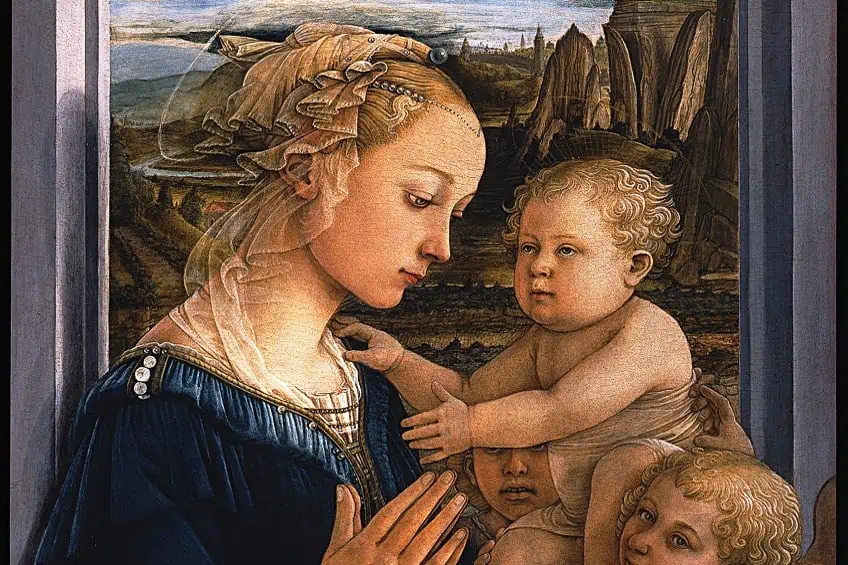Art in Florence – Unveiling the Artistic Tapestry of Florence
If you are visiting Italy any time soon, make sure to mark Florence on your list since it is the most iconic city for exploring the birthplace of Italian art. Most globally renowned art masters have at some point walked the streets of Florence, and how exciting would it be to do the same? From works by Michelangelo to Lorenzo Ghiberti, this article will have you packing your bags to Florence in no time!
Contents
- 1 When in Florence: Explore Art!
- 2 12 Famous Artworks in Florence You Need to See
- 2.1 The Expulsion from the Garden of Eden (c. 1425) by Masaccio
- 2.2 The Gates of Paradise (1425 – 1452) by Lorenzo Ghiberti
- 2.3 Frescoes in the Convento di San Marco (1438 – 1450) by Fra Angelico
- 2.4 David (c. 1440s) by Donatello
- 2.5 Madonna and Child With Two Angels (1460 – 1465) by Filippo Lippi
- 2.6 Primavera (c. 1480) by Sandro Botticelli
- 2.7 The Birth of Venus (1485 – 1486) by Sandro Botticelli
- 2.8 David (1501 – 1504) by Michelangelo
- 2.9 Madonna della Seggiola (1513 – 1514) by Raphael
- 2.10 Venus of Urbino (c. 1534) by Titian
- 2.11 The Last Judgment (1572 – 1579) by Giorgio Vasari and Federico Zuccari
- 2.12 Medusa (1595 – 1598) by Caravaggio
- 3 Frequently Asked Questions
When in Florence: Explore Art!
Nestled in the heart of Tuscany, Florence is the enchanting birthplace of Italian art that never fails to capture the hearts of millions of tourists and art lovers who grace its streets. The city maintains its allure through its many cultural sanctuaries, institutions, and historical architecture that captivates all who visit. Each year, tourists flock to Florence to tread the same cobblestones that some of the art world’s greatest masters once walked on. From works like The Birth of Venus in the Uffizi Gallery to the halls of the Accademia Gallery, which is home to Michelangelo’s David, one will always find a globally famous work of art to marvel at.
The city itself was home to many artists who shaped the backbone of the European art world, including residents like Leonardo da Vinci, who birthed unforgettable works like Annunciation and Filippo Brunelleschi, whose architectural genius amplified the majestic atmosphere of the dome of Florence Cathedral.

If one must ask, why do tourists return to Florence time and again? You will be excited to learn that art permeates Florence in every corner, from the Ponte Vecchio, where one can spot the shops watching over the Arno River to the many intriguing narrow alleys, one will experience the unique and intimate history of the city. What makes art in Florence so unique is that it is embedded in the very fabric of the city, such that it becomes an immersive experience filled with the aroma of espresso, the sounds of street musicians, and many visual pleasures!
Each encounter is also guaranteed to bring you a new experience, so, there are always more reasons to make Florence a regular destination.
12 Famous Artworks in Florence You Need to See
You might feel overwhelmed by the amount of art in Florence and the many destinations you need to look out for. Luckily for you, we have compiled a list of the 12 most famous artworks in Florence that are a must-see when touring Italy!
The Expulsion from the Garden of Eden (c. 1425) by Masaccio
| Artist Name | Tommaso di Ser Giovanni di Simone (1401 – 1428) (Professionally known as Masaccio) |
| Date | c. 1425 |
| Medium | Fresco |
| Dimensions (cm) | 17.7 x 5 x 27.9 |
| Where It Is Housed | Brancacci Chapel, Florence, Italy |
The iconic 15th century Florentine artwork titled Expulsion from the Garden of Eden rests at the Brancacci Chapel in Florence and is recognized as a master work of the famous Renaissance master Masaccio. The Florentine artist was credited as the first great painter of the Quattrocento era in Italian art history, whose work in Expulsion from the Garden of Eden showcases his knowledge of mathematical perspective and eye for depth.
Although the painting was created by Masaccio, it was completed in part by Filippino Lippi.
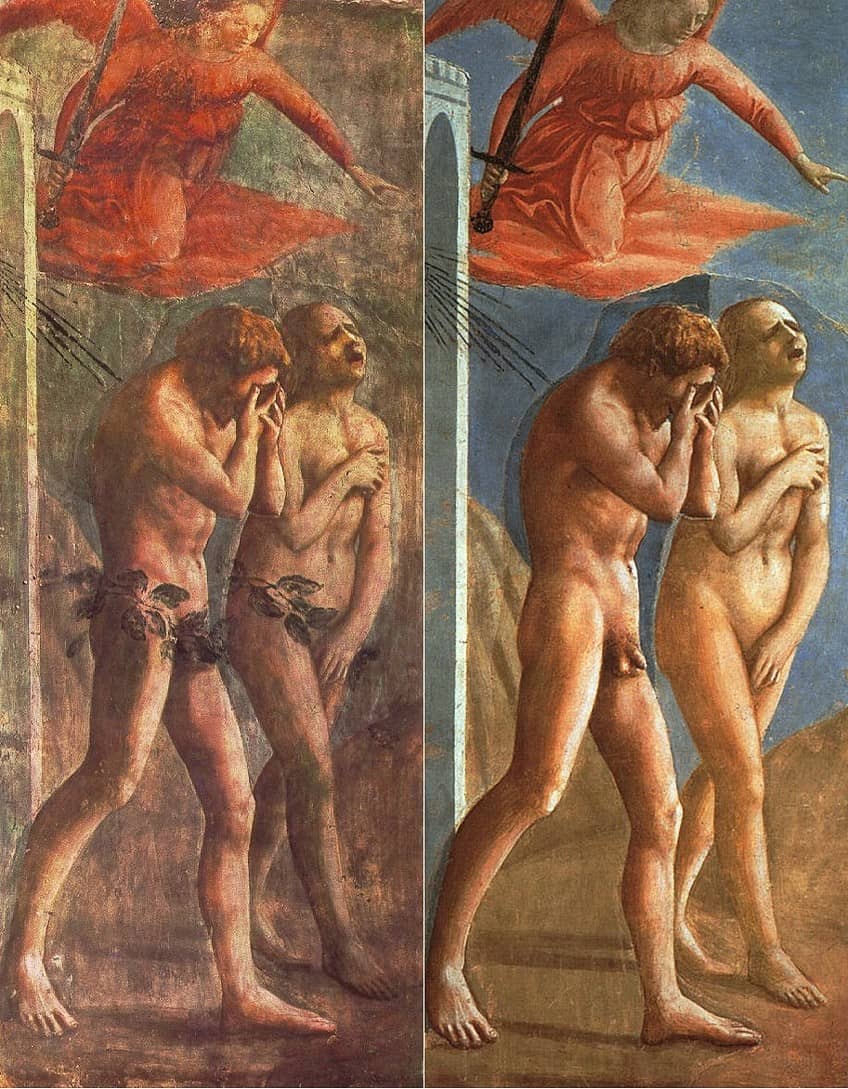
It is recognized for its depiction of a popular biblical narrative that describes the expulsion of the first humans to earth. Masaccio demonstrated his mastery over form and color, which is especially prominent in the expressions of guilt on the figures’ faces. The work captures a very profound emotion that resonates widely with whoever encounters it.
The Gates of Paradise (1425 – 1452) by Lorenzo Ghiberti
| Artist Name | Lorenzo Ghiberti (1378 – 1455) |
| Date | 1425 – 1452 |
| Medium | Bronze |
| Dimensions (cm) | 767.5 x 473 |
| Where It Is Housed | Baptistry of Florence Cathedral (Battistero di San Giovanni), Florence, Italy |
This world-famous pair of gilded bronze doors was designed and sculpted by 15th century sculptor Lorenzo Ghiberti, who won a competition to create the doors for the northern side of the Baptistery of St. John. This sculpture is a must-see work of art that will have you in awe of the excellence of Ghiberti and his eye for detail in including scenes of Christ’s life that embodies one of the universal themes of Renaissance art.
Ghiberti was a talented bronze caster who was also a respected draftsman, goldsmith, and architect.
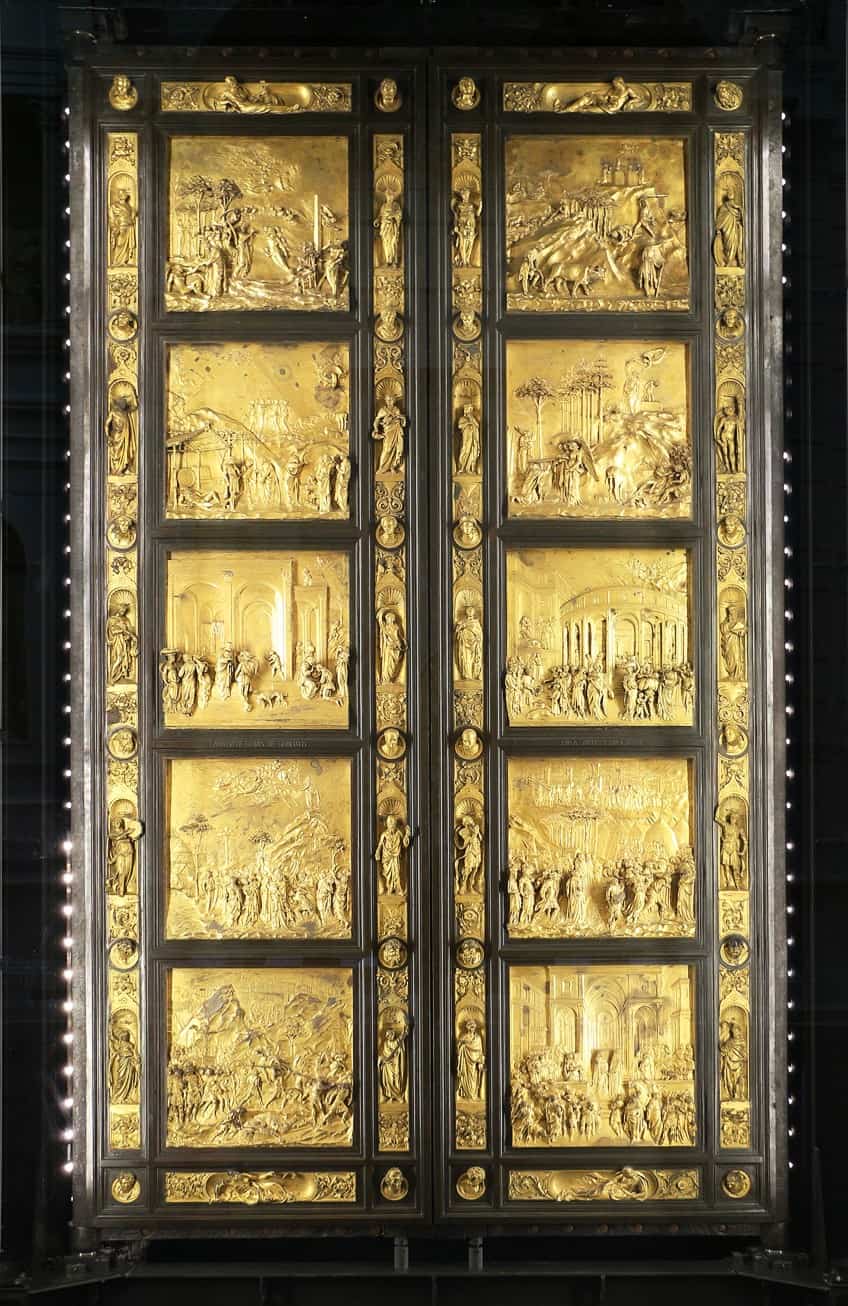
By 1425, he was widely recognized in Florence as the most accomplished sculptor, resulting in this spectacular sculpture, which took the artist 27 years to complete, such that you can enjoy and appreciate his contribution today.
Frescoes in the Convento di San Marco (1438 – 1450) by Fra Angelico
| Artist Name | Fra Angelico (1395 – 1455) |
| Date | 1438 – 1450 |
| Medium | Fresco |
| Dimensions (cm) | Varied |
| Where It Is Housed | San Marco Museum, Florence, Italy |
Fra Angelico’s frescoes are a must-see if you are in the vicinity of the Convento di San Marco. These frescoes were created by the Dominican friar between 1438 and 1450 and are one of the best attractions in Florence. The famous Florentine artworks are recognized for their intimate spiritual subjects that offer a serene experience for those who appreciate religious art and a more intimate encounter. Fra Angelico captured these biblical scenes in the spirit of the early Renaissance period that showcases his masterful painting style and religious devotion.
Fra Angelico was also one of the major painters of the Renaissance whose works have been celebrated as masterworks of Western art.
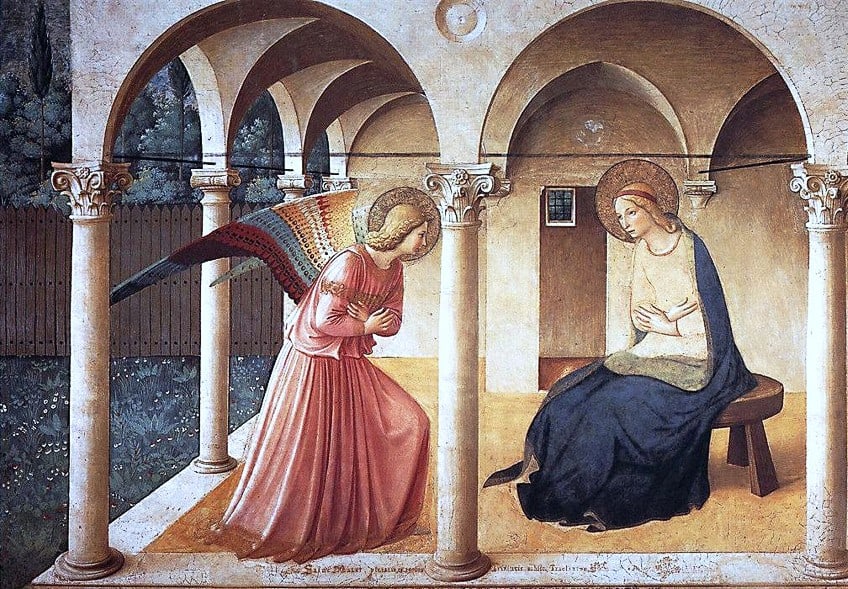
David (c. 1440s) by Donatello
| Artist Name | Donato di Niccolò di Betto Bardi (Donatello) (1386 – 1466) |
| Date | c. 1440s |
| Medium | Bronze |
| Dimensions (cm) | 158 (h) |
| Where It Is Housed | The Bargello, Florence, Italy |
Donatello’s David is a cultural and artistic masterpiece that reflects an alternative view of the character David as graceful, soft, and poised. The famous statue was created by Donatello and is currently on display at the Bargello Museum.
What makes the sculpture so profound is its contemporary depiction of the nude male figure, which was unconventionally rendered for a work of the Renaissance.
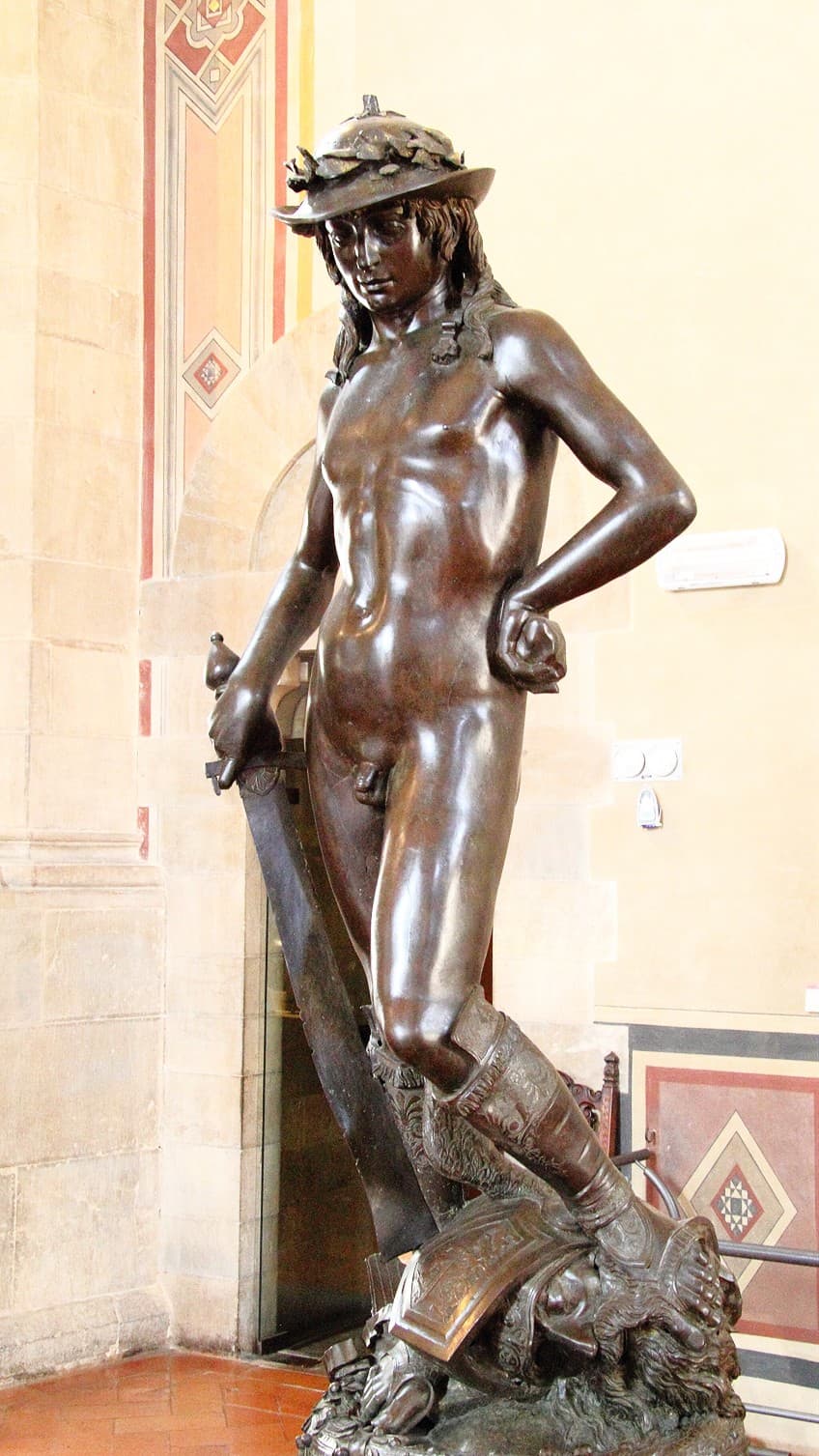
One can admire the many exquisite details of the sculpture, from the figure’s contemplative expression to his feathered hat, which truly captures Donatello’s skills. The statue is also recognized as the first free-standing artwork sculpture since antiquity that pioneered a new approach to common narratives around form.
Madonna and Child With Two Angels (1460 – 1465) by Filippo Lippi
| Artist Name | Filippo Lippi O.Carm. (1406 – 1469) |
| Date | 1460 – 1465 |
| Medium | Tempera on panel |
| Dimensions (cm) | 92 x 63.5 |
| Where It Is Housed | Uffizi Gallery, Florence, Italy |
Madonna and Child With Two Angels is perhaps one of the most famous Italian Renaissance paintings you could ever witness in Florence. The iconic painting of the Madonna was created in the mid-15th century by Filippo Lippi. Lippi was known to be an eccentric character, who was also a womanizer and once abducted a young nun and allegedly assaulted her, resulting in a scandalous reputation and the birth of his son, Filipino Lippi.
One might, at first glance, consider this famous painting as one of the most pious representations of the Madonna, however, it is filled with as much scandal as the artist’s life.

Lippi had reportedly used the image of the nun whom he assaulted as his model and depicted Mary in a distant mood toward the baby Jesus. However, she is portrayed as smiling mysteriously at the angel, who was rumored to be her son, Filipino Lippi.
Primavera (c. 1480) by Sandro Botticelli
| Artist Name | Alessandro di Mariano di Vanni Filipepi (professionally known as Sandro Botticelli) (1445 – 1510) |
| Date | c. 1480 |
| Medium | Tempera on panel |
| Dimensions (cm) | 202 x 314 |
| Where It Is Housed | Uffizi Gallery, Florence, Italy |
While you are browsing the Uffizi Gallery, make sure to head straight to the iconic Sandro Botticelli painting Primavera, which is known to captivate viewers for its mythological beauty. The painting is recognized for its use of allegorical figures in an enchanting blend of timeless Greek mythology and aesthetics, which make the painting a must-see artwork. Additionally, the painting reflects the Pagan beliefs in Western art that was commissioned by Pierfrancesco de’ Medici and was believed to symbolize fertility, as seen in the representation of Cupid flying over a grove of ripe oranges.
There are also nearly 200 identifiable flowers with 130 out of the 200 being recognizable with the main characters Venus carried by Zephyrus and the three graces.
Primavera (c. 1480) by Sandro Botticelli; Sandro Botticelli, Public domain, via Wikimedia Commons
The Birth of Venus (1485 – 1486) by Sandro Botticelli
| Artist Name | Alessandro di Mariano di Vanni Filipepi (professionally known as Sandro Botticelli) (1445 – 1510) |
| Date | 1485 – 1486 |
| Medium | Tempera on canvas |
| Dimensions (cm) | 172.5 x 278.5 |
| Where It Is Housed | Uffizi Gallery, Florence, Italy |
The Birth of Venus by favored Medici painter The Birth of Venus is among the most famous Florentine artworks in the world, and a painting that you simply have to see. Housed at the Uffizi Gallery, the iconic tempera painting depicts the arrival of the goddess of beauty and love, Venus, on the shores of Cyprus. The work was produced for decorative purposes for the prominent Medici family in the 15th century and is known to have been the first Tuscan produced painting created using canvas and not wood, as it was for most artists in the 15th century.
It was also among the first secular paintings to depict a near-life-sized nude figure, which was controversial for its time.
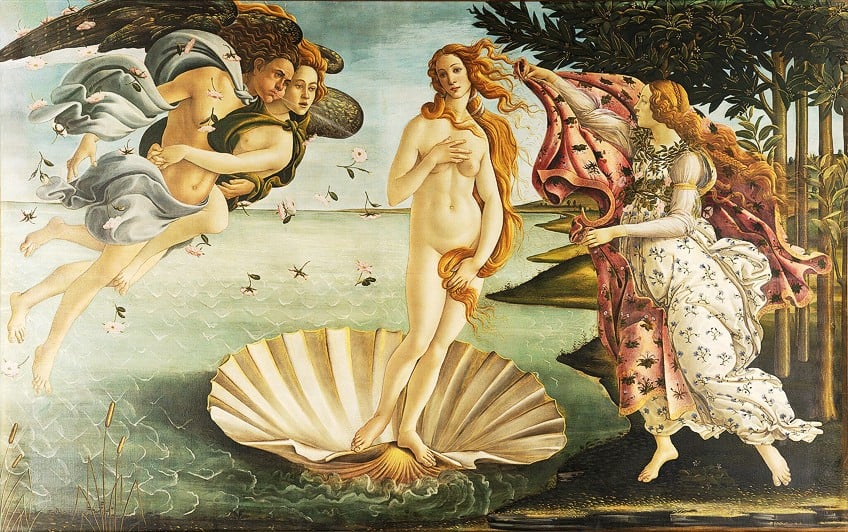
David (1501 – 1504) by Michelangelo
| Artist Name | Michelangelo di Lodovico Buonarroti Simoni (1475 – 1564) |
| Date | 1501 – 1504 |
| Medium | Carrara marble |
| Dimensions (cm) | 517 x 199 |
| Where It Is Housed | Accademia Gallery, Florence, Italy |
A masterpiece of the High Renaissance, David is one such artwork you simply cannot miss at all costs when visiting Florence. The famous marble statue was created by none other than master sculptor Michelangelo, who created the work during a historically significant period in Florence, shortly after the expulsion of the Medici family.
This artwork beautifully captures the height of the Italian Renaissance while showcasing the master workmanship of one of Italy’s most famous sculptors in art history.
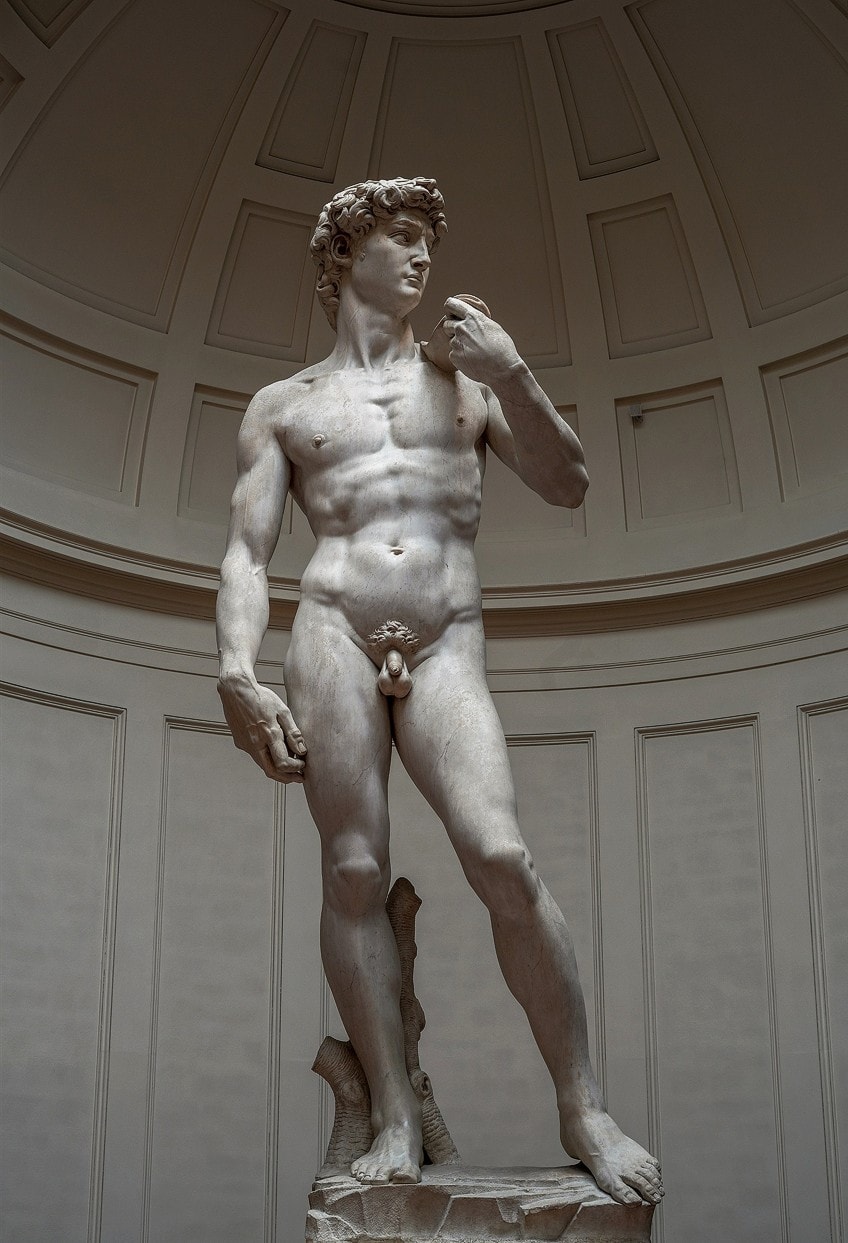
Another interesting fact about the creation of David by Michelangelo was that the subject of David, inspired by the biblical character, was one of the most popular subjects for artists to explore at the time. The figure of David thus began to symbolize not only the heroism and idealized source of intellectual and brute force, but also the defense of civil liberties that were embedded in the constitution of the Republic of Florence in 1494.
Madonna della Seggiola (1513 – 1514) by Raphael
| Artist Name | Raffaello Sanzio da Urbino (1483 – 1520) |
| Date | 1513 – 1514 |
| Medium | Oil on panel |
| Dimensions (cm) | 71 x 71 |
| Where It Is Housed | Palazzo Pitti, Florence, Italy |
When in Florence, you cannot forget to browse the work of Raphael, which can be spotted at Palazzo Pitti in Florence. The famous painting Madonna della Seggiola is among the most renowned artworks by Raphael in Florence that depicts the biblical character Mary embracing Jesus Christ and watched over by the young John the Baptist.
The painting was created between 1513 and 1514 and was commissioned by an unknown patron and stationed among the Medici family since its creation.
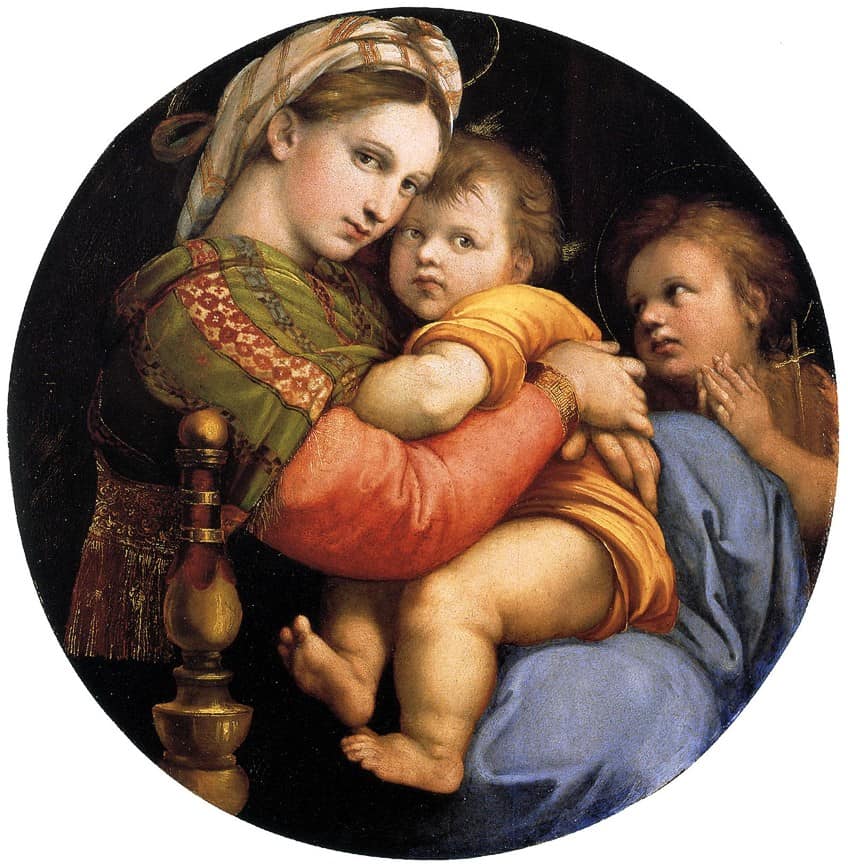
The artwork’s format takes on the circular tondo format in a naturalistic rendering of the Madonna, which was a signature approach of Raphael. The work is also admired for its depiction of an innocent-looking Christ and Mary’s role as a loving mother through her compassionate gaze.
Venus of Urbino (c. 1534) by Titian
| Artist Name | Tiziano Vecelli (1488 – 1576) |
| Date | c. 1534 |
| Medium | Oil on canvas |
| Dimensions (cm) | 119 x 165 |
| Where It Is Housed | Uffizi Gallery, Florence, Italy |
One cannot ask for anything more authentically “Renaissance” than witnessing the work of Titian, one of the greatest painters of the 16th century. Venus of Urbino is one such Titian artwork that was created around 1534 and continues to captivate art enthusiasts and historians for its sensuous rendering of beauty and love. The painting portrays a reclining nude Venus in lush and rich colors that are completed with a brilliant balance of light and shadow, reflecting the Venetian Renaissance at the pinnacle of artistic expression.
The painting was commissioned for the Duke of Urbino and is acknowledged as a symbol of feminine beauty through the Italian male gaze.
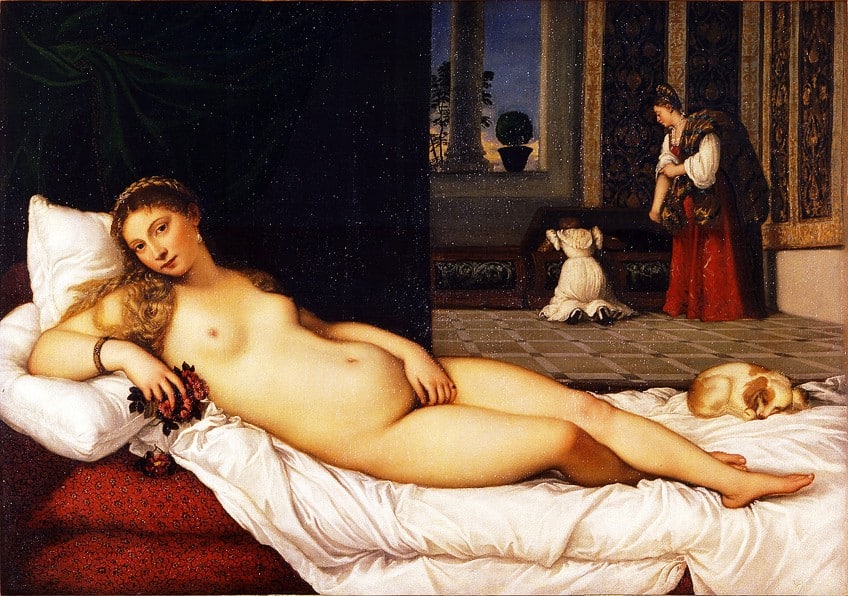
The legacy of the painting has also had a great influence on Western art that unapologetically celebrates the female form. One of the most interesting aspects about the work is that it was created as a moral guide for the duke’s bride Giulia Varano. Additionally, one can explore a step further by researching the symbolism behind the erotic display of Venus and the dog, which symbolizes faithfulness.
The Last Judgment (1572 – 1579) by Giorgio Vasari and Federico Zuccari
| Artist Name | Giorgio Vasari (1511 – 1574) and Federico Zuccari (1539 – 1609) |
| Date | 1572 – 1579 |
| Medium | Fresco |
| Dimensions (cm) | 360,000 |
| Where It Is Housed | Cattedrale di Santa Maria del Fiore, Florence, Italy |
Tucked within the Santa Maria del Fiore Cathedral, this stunning 3,600-meter fresco on the interior of the Duomo adorns the ceiling of the cathedral and was completed by Giorgio Vasari and Federico Zuccari between 1572 and 1579. The fresco was created on the intricate marble flooring of the dome structure and depicts a scene from the Bible known as the Last Judgment.
One can also take a closer look at the dome by trekking up the 463 stairs to a viewing platform, where one can get a better view of The Last Judgment fresco.

The painting was commissioned by the Grand Duke Cosimo I de Medici and was designed by Giorgio Vasari in 1572. However, Vasari passed away before the completion of the fresco and had to be completed by Federico Zuccari in 1579. The style of the fresco mirrors the conservative Tuscan approach, which is a signature style of Vasari. Upon the completion of the fresco, Zuccari commemorated the project by commissioning a medallion, which can be found at the Bargello Museum.
Medusa (1595 – 1598) by Caravaggio
| Artist Name | Michelangelo Merisi (1571 – 1610) (Professionally known as Caravaggio) |
| Date | 1595 – 1598 |
| Medium | Oil on canvas mounted on wood |
| Dimensions (cm) | 60 x 55 |
| Where It Is Housed | Uffizi Gallery, Florence, Italy |
Caravaggio’s Medusa is one painting from the 16th century that beckons visitors to Florence with its striking and expressive portrayal of the mythical Gorgon Medusa, as a bloody, severed head. One of the most eye-catching aspects about the painting are the writhing snakes and the terror-stricken eyes with which Caravaggio chose to express Medusa’s emotions. This also leads to a visceral impact on the viewer as the artist also channels a Baroque spirit and sanitized idealism from the Renaissance era.
His dark yet dramatic color palette also enhances the raw and emotionally-charged atmosphere of a very blunt and realistic rendition of Medusa.

While many people assume Medusa to represent a monstrous being, she was also described by the poet Ovid as “renowned for her loveliness”. However, Medusa was wronged by Poseidon, who raped her in the temple of Athena, and as a result, had her hair transformed into snakes, which soon became an enduring symbol of feminine rage.
These 12 famous Italian artworks are ones you certainly need to check off on your list when enjoying the many wonders that Florence has to offer. We hope that you are just as excited to get to know more about the history of Florentine art and artists as you encounter other works from the Italian Renaissance that capture your heart!
Frequently Asked Questions
What Is the Most Famous Sculpture in Florence?
David (1501 – 1504) by Michelangelo is the most famous sculpture in Florence and is a must-see for any tourist and art lover who plans on visiting the Galleria dell’Accademia di Firenze in Italy.
What Is the Most Famous Painting in Florence?
The Birth of Venus by Sandro Botticelli is considered to be the most famous painting in Florence. The artwork is housed at the Uffizi Gallery and was created between 1485 and 1486 for the Medici family.
Which Famous Artists Lived in Florence?
Among the most famous Italian artists who lived in Florence included Sandro Botticelli, Filippo Lippi, Domenico il Ghirlandaio, Leonardo da Vinci, Michelangelo Buonarroti, Verrocchio, and Raphael.
Jordan Anthony is a Cape Town-based film photographer, curator, and arts writer. She holds a Bachelor of Art in Fine Arts from the University of the Witwatersrand, Johannesburg, where she explored themes like healing, identity, dreams, and intuitive creation in her Contemporary art practice. Jordan has collaborated with various local art institutions, including the KZNSA Gallery in Durban, the Turbine Art Fair, and the Wits Art Museum. Her photography focuses on abstract color manipulations, portraiture, candid shots, and urban landscapes. She’s intrigued by philosophy, memory, and esotericism, drawing inspiration from Surrealism, Fluxus, and ancient civilizations, as well as childhood influences and found objects. Jordan is working for artfilemagazine since 2022 and writes blog posts about art history and photography.
Learn more about Jordan Anthony and about us.
Cite this Article
Jordan, Anthony, “Art in Florence – Unveiling the Artistic Tapestry of Florence.” artfilemagazine – Your Online Art Source. December 14, 2023. URL: https://artfilemagazine.com/art-in-florence/
Anthony, J. (2023, 14 December). Art in Florence – Unveiling the Artistic Tapestry of Florence. artfilemagazine – Your Online Art Source. https://artfilemagazine.com/art-in-florence/
Anthony, Jordan. “Art in Florence – Unveiling the Artistic Tapestry of Florence.” artfilemagazine – Your Online Art Source, December 14, 2023. https://artfilemagazine.com/art-in-florence/.


